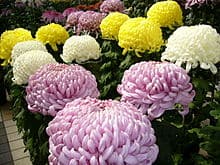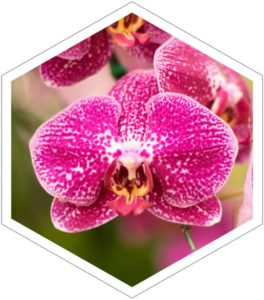Flower Glossary is reader-supported. When you buy through links on our site, we may earn an affiliate commission.
If you’re interested in making a statement, you’ll love our list of tropical flowers. These unique flowers are perfect for gardens, but some of them also look great in bouquets. Check out our list of 20 different types of tropical flowers to get inspired.
Table of Contents
African Violet (Saintpaulia)

Photo Source: https://www.ourhouseplants.com/plants/african-violet
Baron von Saint Paul discovered the African Violet Saintpaulia in 1892. He sent a specimen to Hermann Wendland at Berlin’s Royal Botanic Gardens. Wendland named it Saintpaulia ionantha after its discoverer’s last name.
African violets are a stunning violet color that will bring beauty to any home. It’s important to remember a few tips for growing these delicate beauties.
- Do not place your African Violet in direct sunlight.
- They should be in a brightly lighted area.
- Let compost dry out slightly before watering.
- Soil should remain moist.
- These tropical flowers enjoy high humidity.
- Violets do best in warm weather, around 60-72 degrees. In the winter try to keep your violets as close to 60 degrees as possible.
Amaryllis (Hippeastrum)

Photo Source: https://www.ourhouseplants.com/plants/hippeastrum
The Amaryllis Hippeastrum is a stunning tropical flower. They are usually more expensive in comparison to other flowering bulbs. One reason for the cost is their “reusable” feature. After they die out, the bulbs can grow back as a stunning flower. Here are a few tips to help you cultivate your own Amaryllis.
- These flowers need bright light with some sun for part of the day.
- If purchased while dormant, water the bulbs just enough to make sure the soil is evenly moist. Then wait until you see growth before re-watering.
- As the plant grows, make sure to keep the dirt moist during warmer weather. Reduce watering during the fall months until you come to a complete stop in the winter.
Anthurium (Andraeanum)

Photo Source: https://www.guide-to-houseplants.com/anthurium-plant.html
Anthuriums are some of the most popular tropical flowers. You may also hear them called tail flowers, flamingo flowers, or laceleaf. They’re extra colorful in the warmer months. But, these long-lasting flowers bloom almost all year long. They are a glossy red, pink, or white heart-shaped flower with glossy, dark green leaves.
- Anthuriums grow best with bright light but should stay out of direct sunlight.
- These tropical blooms need moist air and grow better outside. They’ll grow best in an area where the humidity remains at 50% or higher.
- Keep the soil evenly moist in the spring through fall months, but water less in the winter.
- If you notice yellow leaves, you are likely overwatering.
Bird of Paradise (Strelitzia reginae)

Photo Source: https://en.wikipedia.org/wiki/Strelitzia_reginae
The Bird of Paradise is a species of flowering plant indigenous to South Africa. This evergreen perennial is best known for its beautiful and dramatic flowers. The blue and orange blooms resemble a tropical bird.
- These flowers are partial to full sun, so be sure to keep them in a bright and sunny area.
- Be sure to water your Birds of Paradise often. It’s best to do so weekly or more often in extreme heat.
- With proper care, these massive plants can grow to be six feet tall by six feet wide. Be sure to give them plenty of space to expand if planting outdoors.
Blanket Flowers (Gaillardia)

Photo Source: https://en.wikipedia.org/wiki/Gaillardia
The Blanket Flower (Gaillardia) is native to North and South America. It belongs in the sunflower family, Asteraceae. The flower’s name comes from M. Gaillard de Charentonneau. The blanket flower looks like brightly patterned blankets made by Native Americans.
- Blanket flowers grow best in full sun.
- Plant these bright blooms in well-draining soil and avoid clay soil.
- Water your blanket flowers roughly every other day.
- Once fully established, blanket flowers can tolerate extreme drought conditions.
- Established plants can be watered once or twice per week.
Blood Lily (Scadoxus Multiflorus)

Photo Source: https://en.wikipedia.org/wiki/Scadoxus_multiflorus
The Blood Lily (Scadoxus Multiflorus) is a bulbous plant. It is native to sub-Saharan Africa, the Arabian Peninsula, and Seychelles. It is now also found in Mexico and the Chagos Archipelago. This stunning plant is also highly toxic. Due to its toxicity, some use it as a component in arrow and fishing poisons. Locals also make use of the blood lily as a remedy for coughs and digestive problems.
- These bright red flowers usually bloom from June to July.
- They do best in full sun to partial shade.
- Blood lilies cannot handle frost and need to remain at a temperature of 41 degrees or higher.
Blue Passion Flower (Passiflora Caerulea)

Photo Source: https://www.gardenia.net/plant/Passiflora-Caerulea-Blue-Passion-Flower
The Blue Passion Flower (Passiflora Caerulea) is a stunning white or sometimes pink-flushed. Additionally, it features a ring of blue, white and purple filaments.
- Blooms during warm weather from early summer to early fall.
- Blue passion flower grows best in full sun to partial shade.
- Choose loose sandy or gravelly soils, with well-drained moisture.
- This twining vine can quickly grow up to 20-30 feet long.
- This flower attracts butterflies to your garden.
Bougainvillea Glabra

Photo Source: https://en.wikipedia.org/wiki/Bougainvillea_glabra
The Bougainvillea Glabra is an evergreen, climbing shrub that has thorny stems. Tiny white flowers appear in clusters surrounded by colorful papery bracts. As a result, it is also known as the paper flower.
- It will need at least four hours of direct sunlight each day during its active growth period.
- Should not be in temperatures below 50 degrees.
- Water moderately during growth.
Chrysanthemum Morifolium

Photo Source: https://en.wikipedia.org/wiki/Chrysanthemum_morifolium
You may know the Chrysanthemum Morifolium as the florist’s daisy or hardy garden mum. This mum is a perennial plant species belonging to the asteraceae family. It is common as an indoor houseplant because of its air cleaning qualities. It can also help remove chemicals from the air.
- Grow best in full sun but can withstand light shade.
- The soil should be fertile, moist and well-drained.
- Plant in spring after the last frost, late summer or early fall (before September 15th).
Clivia Miniata

Photo Source: https://en.wikipedia.org/wiki/Clivia_miniata
The Clivia Miniata is a flowering plant in the genus Clivia of the family Amaryllidaceae. It grows in woodland habitats in South Africa and Swaziland.
- If grown in their native range they can tolerate light frosts.
- Partial shade is best.
- Water well during warmer months to allow them to dry for the winter.
- If the leaves turn yellow, you may be overwatering.
- If leaves split vertically, they need more sun.
Cyclamen Persicum

Photo Source: https://en.wikipedia.org/wiki/Cyclamen_persicum
The Cyclamen Persicum is a species of flowering herbaceous perennial plant. It grows from a tuber and is native to rocky hillsides, shrubland, and woodland up to 3,900 feet above sea level. They grow from south-central Turkey to Lebanon-Syria and the Palestine region. They also grow in Algeria, Tunisia, and on the Greek Islands of Rhodes, Karpathos, and Crete.
- This plant thrives in temperatures from 50-65 degrees.
- Need a decent amount of light but not direct sunlight.
- Water when the soil becomes dry to the touch.
Heliconia Rostrata
![]()
The Heliconia Rostrata is also known as hanging lobster claw or the false bird of paradise. It is a perennial native to Peru, Columbia, Bolivia, Costa Rica, and Ecuador. These beautiful tropical blooms also now grow in Puerto Rico. This plant has downward-facing flowers which provide nectar to birds.
- Partial shade or full sun is best.
- Soil should be well-draining, fertile and moist.
- They are moderately drought tolerant, and best results come with consistent moisture.
Hibiscus Rosa-Sinensis

Photo Source: https://www.gardenia.net/plant/Hibiscus-rosa-sinensis-Brilliant
The Hibiscus Rosa-Sinensis is a well-branched evergreen shrub with bold cardinal-red flowers.
- Grows best in full to partial shade.
- Grows 8-10 feet tall.
- Can be sensitive to changing conditions in light or temperature.
Larkspur Delphinium

Photo Source: https://home.howstuffworks.com/delphinium-larkspur.htm
The Larkspur Delphinium comes from the Greek word for “Dolphin.” These plants produce tall spikes of showy flowers, which are usually blue. Recognize them by a long spur behind the petals.
- Grow best in well-drained fertile soil.
- Full sun to light shade is best.
- Plant in the spring.
- Can be dangerous to cattle.
Morning Glory Ipomoea Muricata

Photo Source: https://davesgarden.com/guides/pf/go/69456/#b
The Ipomoea Muricata is also known as the Morning Glory. You’ll often see this spectacular, colorful flower grown as an ornamental.
- Full sun to partial shade is recommended.
- Bloom in late summer to early fall.
Orchidaceae

Photo Source: https://www.proflowers.com/blog/tropical-flowers
The Orchidaceae are flowering plants with colorful and fragrant flowers.
- They do best in full sun to partial shade.
- Can reach 1 to 2 feet tall.
- Should be well-drained.
Pink Cosmos (Cosmos Bipinnatus)

Photo Source: https://en.wikipedia.org/wiki/Cosmos_bipinnatus
The Cosmos Bipinnatus typically grow 2-4 feet tall on erect stems with pinnatisect. These are medium green leaves that have darker threadlike segments.
- These blooms need full sun.
- Moderately fertile, moist and well-drained soil.
- Bloom between summer and fall.
Plumeria Rubra

Photo Source: https://en.wikipedia.org/wiki/Plumeria_rubra
The Plumeria Rubra belongs to the genus Plumeria. It is a favorite garden and park plant and commonly used in temples and cemeteries. It has fragrant flowers that are shades of pink, white, and yellow grow on a spreading tree.
- Full to partial shade is best.
- Ensure soil is well-drained.
- Grow on trees that are 20 to 30 feet.
Proteaceae

Photo Source: https://en.wikipedia.org/wiki/Proteaceae
Botanists first saw the Protea Proteaceae in the 17th century. Europeans discovered this beautiful flower in South Africa. It also blooms in Australia and parts of the U.S.
- Full sun is needed.
- Well-drained soil is best.
- Can grow 3-13 feet.
Sampaguita (Jasminum Sambac)

Photo Source: https://en.wikipedia.org/wiki/Jasminum_sambac
The Sampaguita (Jasminum Sambac) is also known as Arabian Jasmine or Sambac Jasmine. It’s a small shrub or vine which has attractive and beautiful scented flowers. Because of their scent, they are a favored ingredient for perfumes and jasmine tea. Sampaguita is the national flower of the Philippines.
- Choose an area with full to partial shade.
- Planted in moist and well-drained soil.
- Grow 3 to 7 feet.
Feeling inspired? Check out 170+ other kinds of flowers
